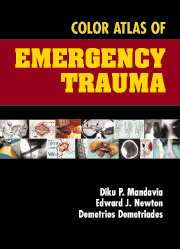5 - ABDOMINAL INJURY
Published online by Cambridge University Press: 10 November 2010
Summary
Blunt Abdominal Trauma
Introduction
Traffic accidents, followed by falls, are by far the most common causes of severe blunt abdominal trauma. Solid organs, usually the spleen and liver, are the most commonly injured organs. Hollow viscus perforations are fairly uncommon, and they are usually associated with seatbelts or high-speed deceleration.
There are five main mechanisms of injury with blunt trauma:
Direct crushing of organs between the anterior and posterior abdominal walls.
Avulsion injuries from deceleration forces, as in high-speed accidents or falls from heights.
Transient formation of closed bowel loop with high intraluminal pressure and rupture of the hollow viscus.
Lacerations by bony fragments (e.g., pelvis, lower ribs).
Sudden and massive elevation of the intraabdominal pressure (usually seatbelted individuals involved in high-speed accidents) may cause diaphragmatic or even cardiac rupture.
Clinical Examination
The clinical evaluation of blunt abdominal trauma is often complicated by associated soft tissue contusion, fractures of the lower ribs or pelvis, head injuries with depressed level of consciousness, and spinal injuries. These conditions make clinical examination difficult and unreliable, and significant hollow viscus injuries may be missed with potentially lethal consequences. Most preventable deaths due to trauma are the result of delayed diagnosis of intra-abdominal injuries. Despite its limitations, physical examination remains the cornerstone of abdominal evaluation. Of particular importance is the “seatbelt sign” on the abdominal wall. Its presence is associated with a high incidence (about 20%) of significant intra-abdominal injuries.
- Type
- Chapter
- Information
- Color Atlas of Emergency Trauma , pp. 129 - 166Publisher: Cambridge University PressPrint publication year: 2003



